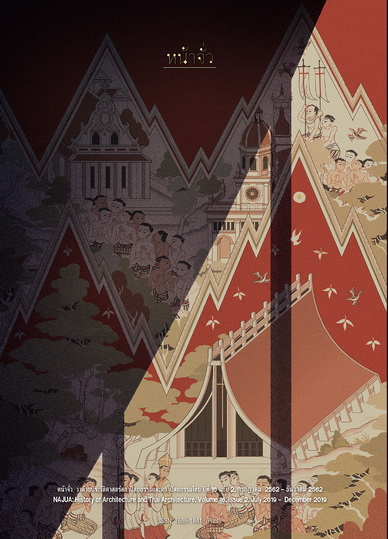Podiums in a Rail-based City Changing the Urbanscape in Central Business District, Bangkok
Main Article Content
Abstract
The study of the present urbanscape of the central business district of Bangkok, Silom - Sathorn area, including its urban design controls reveals the fact that all the related building control law and regulations are merely not enough to ensure the urban regeneration that would yield good quality buildings and public spaces in such important business area in the capital city, Bangkok. This research paper summarizes from a research on changing the urbanscape in central business district, Bangkok. The research methodologies include the analysis of urban planning and design standards, urbanscape related regulations of Bangkok Metropolitan Administration, international case studies, along with the survey of Silom - Sathorn area. The research aims to analytically introduce the guidelines for the area regeneration, especially in term of ‘urban design’ that importantly points out the adjustment of buildings’ “podium” in the central business district. This is to ensure the development of good public spaces that can be responsive to pedestrian environment and human scale at the time when Bangkok has been largely transforming to be a rail-based city in the next decade. The research outcome includes the recommendation that Bangkok should set up ‘urban design review committees’ to help diagnose the project development’s master plan and architectural details in all important urban areas in order to control the quality of the urbanscape in correspond to urban contexts and in addition to incentives and law controls.
Downloads
Article Details
References
American Planning Association. Planning and urban design standards. New Jersey: John Wiley & Sons, 2006.
Bangkok Metropolitan Administration. khrōngkān ʻanurak fư̄nfū phư̄nthī chan nai Krung Thēp Mahā Nakhō̜n Krung Thēp sō̜ngrō̜ihāsip [Bangkok inner urban conservation project, Bangkok 250]. Bangkok: Chulalongkorn Academic Service Center, 2016.
Bangkok Metropolitan Administration. khrōngkān čhattham māttrathān phangmư̄ang khō̜ng Krung Thēp Mahā Nakhō̜n [Bangkok urban planning standard project]. Bangkok: Chulalongkorn Academic Service Center, 2011.
Bangkok Metropolitan Administration. khrōngkān wāng læ čhattham phangmư̄ang rūam Krung Thēp Mahā Nakhō̜n chabap prapprung khrang thī sām [Bangkok comprehensive planning project, the third plan]. Bangkok: Chulalongkorn Academic Service Center, 2013.
Bridtow, R. Planning in Taiwan, spatial planning in the twenty-first century. London and New York: Routledge, 2010.
CC7. Sathorn, Bangkok. Accessed July 29, 2019. Available from http://Shutterstock.com
Chatnara. Silom, Bangkok. Accessed July 29, 2019. Available from http://Shutterstock.com
Cullingworth, Barry, ed. Urban and regional planning in Canada. New Jersey: Transaction Publishers, 2015. Engels, F. The condition of the working-class in England in 1844. London: Penguin Classics, 2009.
Haryey, D. Rebel cities. London and New York: Verso, 2019.
Hutchinson, Mitch. Vancouver. Accessed July 29, 2019. Available from http://Shutterstock.com
Jo Theera. Fukuoka. Accessed July 29, 2019. Available from http://Shutterstock.com
Lefebvre, H. Production of space. Oxford: John Wiley & Sons, 1992.
Moor, M., and J. Rowland, eds. Urban design futures. New York: Routledge, 2017.
Theera, Jo. Fukuoka. Accessed July 29, 2019. Available from http://Shutterstock.com
Simmel, G. “The metropolis and mental life.” In On individualism and social forms, 11-19. Edited by D, Levine. Chicago: University of Chicago Press, 1971.
Stephen, H., and B. Yuen, eds. Planning Singapore, the experimental city. New York: Routledge, 2019.
Tavarius. Taipei. Accessed July 29, 2019. Available from http://Shutterstock.com
Yamu, C., and others, eds. The virtual and the real in planning and urban design. New York: Routledge, 2017.
Yim, Gary. Melbourne. Accessed July 29, 2019. Available from http://Shutterstock.com


